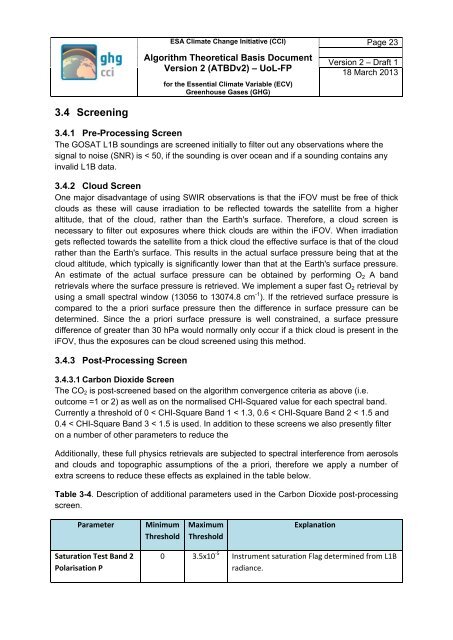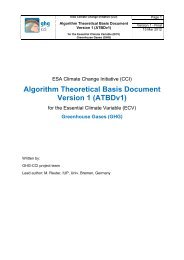ATBD - GHG-CCI
ATBD - GHG-CCI
ATBD - GHG-CCI
You also want an ePaper? Increase the reach of your titles
YUMPU automatically turns print PDFs into web optimized ePapers that Google loves.
ESA Climate Change Initiative (<strong>CCI</strong>)<br />
Algorithm Theoretical Basis Document<br />
Version 2 (<strong>ATBD</strong>v2) – UoL-FP<br />
for the Essential Climate Variable (ECV)<br />
Greenhouse Gases (<strong>GHG</strong>)<br />
Page 23<br />
Version 2 – Draft 1<br />
18 March 2013<br />
3.4 Screening<br />
3.4.1 Pre-Processing Screen<br />
The GOSAT L1B soundings are screened initially to filter out any observations where the<br />
signal to noise (SNR) is < 50, if the sounding is over ocean and if a sounding contains any<br />
invalid L1B data.<br />
3.4.2 Cloud Screen<br />
One major disadvantage of using SWIR observations is that the iFOV must be free of thick<br />
clouds as these will cause irradiation to be reflected towards the satellite from a higher<br />
altitude, that of the cloud, rather than the Earth's surface. Therefore, a cloud screen is<br />
necessary to filter out exposures where thick clouds are within the iFOV. When irradiation<br />
gets reflected towards the satellite from a thick cloud the effective surface is that of the cloud<br />
rather than the Earth's surface. This results in the actual surface pressure being that at the<br />
cloud altitude, which typically is significantly lower than that at the Earth's surface pressure.<br />
An estimate of the actual surface pressure can be obtained by performing O 2 A band<br />
retrievals where the surface pressure is retrieved. We implement a super fast O 2 retrieval by<br />
using a small spectral window (13056 to 13074.8 cm -1 ). If the retrieved surface pressure is<br />
compared to the a priori surface pressure then the difference in surface pressure can be<br />
determined. Since the a priori surface pressure is well constrained, a surface pressure<br />
difference of greater than 30 hPa would normally only occur if a thick cloud is present in the<br />
iFOV, thus the exposures can be cloud screened using this method.<br />
3.4.3 Post-Processing Screen<br />
3.4.3.1 Carbon Dioxide Screen<br />
The CO 2 is post-screened based on the algorithm convergence criteria as above (i.e.<br />
outcome =1 or 2) as well as on the normalised CHI-Squared value for each spectral band.<br />
Currently a threshold of 0 < CHI-Square Band 1 < 1.3, 0.6 < CHI-Square Band 2 < 1.5 and<br />
0.4 < CHI-Square Band 3 < 1.5 is used. In addition to these screens we also presently filter<br />
on a number of other parameters to reduce the<br />
Additionally, these full physics retrievals are subjected to spectral interference from aerosols<br />
and clouds and topographic assumptions of the a priori, therefore we apply a number of<br />
extra screens to reduce these effects as explained in the table below.<br />
Table 3-4. Description of additional parameters used in the Carbon Dioxide post-processing<br />
screen.<br />
Parameter<br />
Minimum<br />
Threshold<br />
Maximum<br />
Threshold<br />
Explanation<br />
Saturation Test Band 2<br />
Polarisation P<br />
0 3.5x10 -5 Instrument saturation Flag determined from L1B<br />
radiance.




